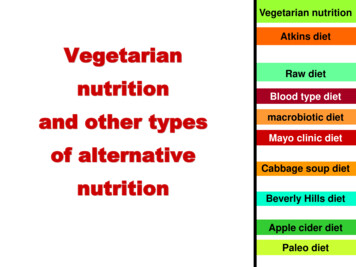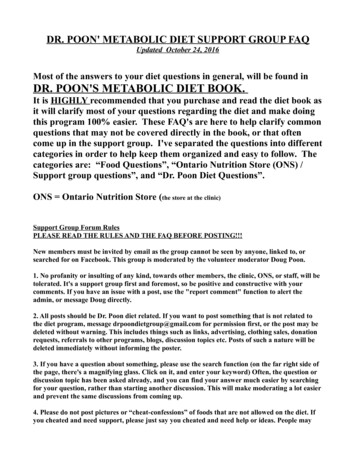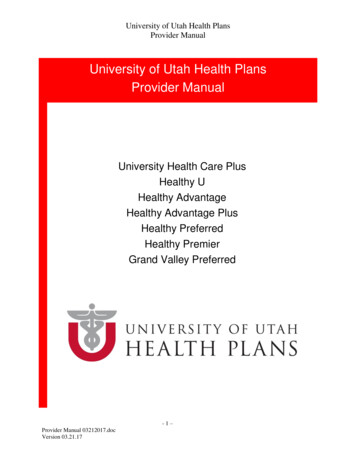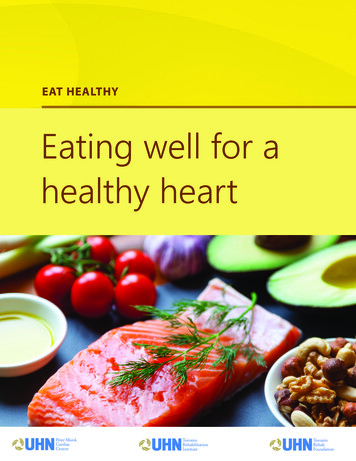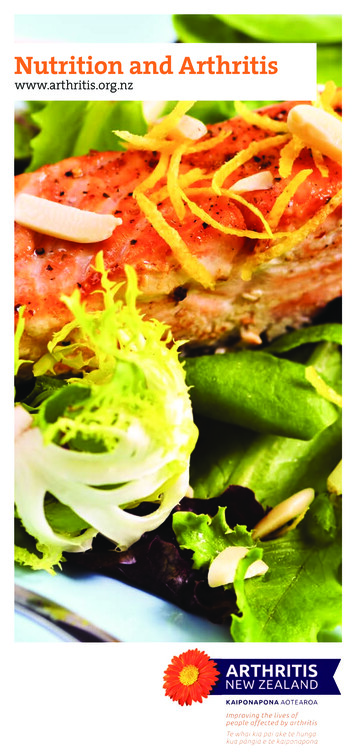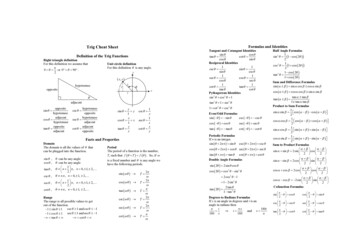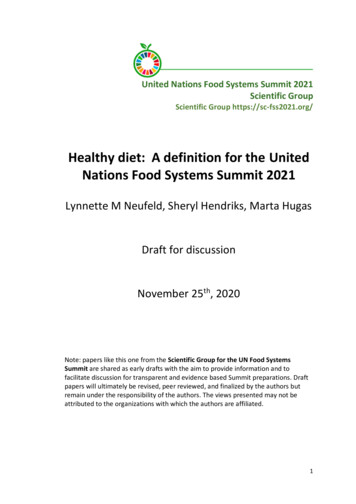
Transcription
United Nations Food Systems Summit 2021Scientific GroupScientific Group https://sc-fss2021.org/Healthy diet: A definition for the UnitedNations Food Systems Summit 2021Lynnette M Neufeld, Sheryl Hendriks, Marta HugasDraft for discussionNovember 25th, 2020Note: papers like this one from the Scientific Group for the UN Food SystemsSummit are shared as early drafts with the aim to provide information and tofacilitate discussion for transparent and evidence based Summit preparations. Draftpapers will ultimately be revised, peer reviewed, and finalized by the authors butremain under the responsibility of the authors. The views presented may not beattributed to the organizations with which the authors are affiliated.1
The Scientific Group for the UN Food Systems Summit is an independent group of leading researchers andscientists from around the world. Its members are responsible for ensuring the robustness, breadth andindependence of the science that underpins the Summit and its outcomes.Scientific Group https://sc-fss2021.org/ ipJoachim von Braun (Germany) Chair of the Scientific Group. Director of the Center for Development Research (ZEF), BonnUniversity, and Professor for economic and technological change.Kaosar Afsana (Bangladesh) Vice Chair of the Scientific Group. Professor Public Health, BRAC University.Louise Fresco (Netherlands) Vice Chair of the Scientific Group. President of the Executive Board, Wageningen University &Research.Mohamed Hassan (Sudan) Vice Chair of the Scientific Group. President of The World Academy of Sciences for theadvancement of science in developing countries (TWAS).Mario Herrero Acosta (Costa Rica) Chief Research Scientist of Agriculture and Food, The Commonwealth Scientific andIndustrial Research Organisation (CSIRO).Ousmane Badiane (Senegal) Chairperson of Akademiya2063, former Africa Director for the International Food PolicyResearch Institute (IFPRI).Patrick Caron (France) Vice President of the University of Montpellier, President of Agropolis International and Director ofthe Montpellier Advanced Knowledge Institute on TransitionsMartin Cole (Australia) is Professor for Agriculture and Food within the Commonwealth Science and Industrial ResearchOrganisation (CSIRO). Chairperson of the HLPE Steering Committee of CFS.Ismahane Elouafi (Morocco) Chief Scientist, Food and Agriculture Organization of the United Nations (FAO).Frank A. Ewert (Germany) Scientific Director, Leibniz Centre for Agricultural Landscape Research (ZALF).Sheryl L. Hendriks (South Africa) Professor of Food Security & Director, Institute for Food, Nutrition and Well-being,University of Pretoria.Thomas W. Hertel (USA) Professor of Agricultural Economics at Purdue University and Executive Director of the GlobalTrade Analysis Project (GTAP).Jikun Huang (China) Professor at School of Advanced Agricultural Sciences and Director of China Center for AgriculturalPolicy (CCAP), Peking University.Marta Hugas (Spain) Chief Scientist at European Food Safety Authority (EFSA).Elizabeth Hodson de Jaramillo (Colombia) Professor Em. School of Sciences of the Pontificia Universidad Javeriana, andmember of Inter American Network of Academies of Sciences (IANAS).Andrew Kambugu (Uganda) Executive Director Infectious Diseases Institute (IDI), College of Health Sciences, MakerereUniversity. Co-founder of the Researchers for Global Health (R4GH) initiative.Kaoru Kitajima (Japan) Professor at Kyoto University Graduate School of Agriculture; a forest ecologist, especially intropical America and Asia.Rattan Lal (India) Professor of Soil Science, Director of the Carbon Management and Sequestration Center at Ohio StateUniversity. World Food Prize Laureate 2020.Hoesung Lee (South Korea) Chair, Intergovernmental Panel on Climate Change (IPCC), Professor at Korea UniversityGraduate School of Energy and Environment, Seoul.Uma Lele (India) is President of the International Association of Agricultural Economists (IAAE).Lynnette M. Neufeld (Canada) incoming President of the International Union of Nutrition Scientists (IUNS), DirectorKnowledge Leadership, Global Alliance for Improved Nutrition (GAIN).Urs Niggli (Switzerland) Scientist focusing on sustainable farming systems, from 1990 to 2020 he led the Research Instituteof Organic Agriculture (FiBL)Claudia Sadoff (USA) Executive Management Team Convener and Managing Director, Research Delivery and Impact, of theConsultative Group on International Agricultural ResearchLisa Sennerby Forsse (Sweden) past President, Royal Swedish Academy of Agriculture and Forestry (KSLA) and was thevice-chancellor of the Swedish University of Agricultural Sciences 2006-2015.Jean-François Soussana (France) is Vice-President of International Policy at the Institute national de la rechercheagronomique (INRAE).Morakot Tanticharoen (Thailand) Professor and Senior Advisor to the President of the National Science and TechnologyDevelopment Agency (NSTDA), research in microbiology and biotechnology.Maximo Torero (Peru) ex-officio Member Chief Economist, Food and Agriculture Organization of the United Nations (FAO).Aman Wirakartakusumah (Indonesia) Professor Em. at Department of Food Science and Technology and Senior Scientist atSEAFAST Center, Bogor Agricultural University (IPB), President-Elect, International Union of Food Science and Technology.David Zilbermann (Israel, USA) Professor in the Department of Agricultural and Resource Economics, University ofCalifornia at Berkeley. One of the Founders of the International Consortium of Applied Bio-economy Research (ICABR).2
Healthy diet: A definition for the United Nations Food Systems Summit 2021Definition:A healthy diet is one that is human health promoting and disease preventing, and safeguarding ofplanetary health by: Providing adequacy without excess, of nutrients from foods that are nutritious and healthyAvoiding the introduction of health-harming substances, through all stages of the value chain.Healthy diets must be affordable, culturally acceptable. They must progressively change towardsoriginating from sustainable production and processing systems that do not adversely affect local andregional ecologies.Rationale:The aim of this document is to propose a simple definition of a healthy diet that permits the alignmentof terminology for the Food Systems Summit, and highlights several critical challenges related to thethree components of a healthy diet highlighted above. The evidence and potential solutions toachieving healthy diets, including all considerations noted, is the subject of the Action Track andScience Group papers and is not addressed here.What constitutes a healthy diet has been the source of debate in the nutrition community for decades.Innumerable definitions exist, with many similarities and several contradictions over time.1 Thecontradictions arise at least in part from diversity in the underlying health issues that the dietsintended to address. Some diets are based on observed dietary patterns in populations where certaindiseases, particularly non-communicable diseases (NCDs) appear less prevalent. Studies have thentested these dietary patterns in population sub-groups for the potential to promote health or preventdisease in other contexts (e.g., Mediterranean diet2). Although the topic of much research,1 such dietsdo not consider all potential health outcomes across all contexts. Nor do they account for localavailability and affordability of food types or the cultural traditions and acceptable of foods. Anotherapproach has been to model optimal dietary patterns for a specific food group, based on consumptionand mortality data.3 But several challenges remain, including lack of dietary data from manypopulations and sub-groups.Food safety is rarely articulated explicitly as part of a healthy diet, yet it is implicitly assumed. Withoutensuring safety, foods cannot nourish and instead will cause illness. The World Health Organization(WHO) has identified a series of guiding principles of healthy diets that seek to address all forms ofmalnutrition and related health issues, and permit contextualization to individual characteristics,cultural contexts, local foods and dietary customs rather than suggesting a prescriptive approach.4Building on such evidence, Food based dietary guidelines (FBDG) are intended to provide the basis fornational food and agricultural policies and have been developed by over 100 countries. 5 The contentof FBDG can be varied but generally include a set of recommendations for foods, food groups, anddietary patterns that minimize risk of deficiencies, promote health and prevent disease in specificcontexts.3
The idea of extending the definition of healthy diets to include considerations of environmental orplanetary health in addition to human health is not new. Principles to guide a “sustainable healthydiet”, based primarily on eating local and minimizing processed food were published as early as 19866.Form the start, these principles have received considerable criticism from the nutrition, agriculture,and food sectors.7 Aligned with the approach for healthy diets, FAO and WHO have set out a series ofguiding principles for the achievement of contextually appropriate sustainable, affordable, healthydiets.8,9 The recent EAT-Lancet Commission on Healthy Diets from Sustainable Food Systems took aprescriptive approach, providing specific recommendations for food groups and the quantities of foodin each group that promote human health and can be produced within planetary boundaryconsiderations.10 Like the earlier efforts, the EAT-Lancet Commission diet has received criticism onseveral fronts, including lack of consideration for food affordability.11 The Commission however, callsfor research to adapt the diet to local contexts. Future studies may provide evidence of this potential.There will always be tensions between the indicative or guiding principles approach to defining ahealthy diet, which leaves much room for interpretation, and the prescriptive approach which tendsto underestimate the complexities of extrapolation for age, sex, life-stage, culture, food availability,affordability, among other considerations. Despite these challenges, guidance on what constitutes ahealthy diet – one that promotes human health, prevents disease, and safeguards the planet - remainscritically important.4
1. Foods that are nutritious and healthyDefinition and rationale:A nutritious and healthy food is “one that provides beneficial nutrients (e.g. vitamins, minerals,essential amino acids, essential fatty acids, dietary fibre) and minimizes potentially harmful elements(e.g. anti-nutrients, quantities of sodium, saturated fats, sugars)” (GAIN,12 drawing on definitionspublished by Drewnowski13 and Katz et al14). While conceptually simple, there is no easy universallyaccepted approach to classifying foods in this regard. Similarly, some context specificity is required inthe categorization of individual foods as nutritious and healthy. The same food, for example whole fatmilk may provide much needed nutrients to one population group (e.g., underweight 3-year-oldchildren), but be less “healthy” for another due to its high calorie and fat content (e.g., obese adults).“Nutrient profiling” or the rating of foods based on their nutrient density (i.e., nutrient content per100 g or per 100 kcal or per serving) has evolved substantially in recent years as an approach toclassifying individual foods.13,15 Such scores now provide the basis for several regulatory and healthpromotion-aimed efforts, including front of pack labelling and health claims.16 Recent efforts havealso proposed more complete profiling approaches that in addition to nutrient density, take intoconsideration the food groups of ingredients (e.g., fruit or vegetable content), and develops furtherthe content of ingredients (e.g., types of fat) that should be limited.15 To date, nutrient-profiling hasbeen used predominantly for packaged foods in many high-income and several middle-incomecountries. Important limitations remain for extending its utility to unpackaged foods and in contextswhere a large portion of food is not commercially produced.Challenges to establish “adequacy without excess of nutrients” from food:Imperfect characterization of population nutrient requirements to avoid deficiency and promotehealth: Reference values for nutrient intakes of humans have been established focussing on theavoidance of deficiency and excess. Nutrient requirements vary by age, sex, and life stage (e.g.,pregnancy), and among individuals such that no single value, even within age/ sex groups can bedefined. Estimated average requirements are therefore developed and converted into recommendeddaily nutrient intake levels that will, at the population level ensure that the requirements of 95% ofthe population are met.17 Upper tolerable limits are set at the minimum level above which potentialdeleterious effects may be observed. At this time, there is no single set of recommended nutrientintakes that has been globally accepted and estimates are made using diverse methodologicalapproaches. Experts are now calling for such efforts to be harmonized with a transparent andconsistent approach.18In addition to the focus on nutrient deficiency avoidance, much research has focused on the potentialhealth effects – both positive and negative - of consuming specific foods, food groups or dietarypatterns.1 Evidence for the health promoting components of the diet (e.g., fruits and vegetables; nutsand seeds) and for the health harming effects of excess quantities of some nutrients or dietarycomponents, for example, trans fat, salt, sugar, forms the basis of the guidelines proposed by FAO,8,19WHO,4 and the HLPE.9 While the basic tenants of these guidelines are unlikely to change, evidence forall dietary components continues to evolve, and to some extent is constrained by the imperfectestimates of nutrient requirements and upper tolerable limits discussed above. Some have also calledfor greater transparency and better management of commercial interests in research of theassociations between food products and health outcomes. 20 Emerging evidence suggests thateventually, dietary recommendations may be personalized to optimize human health outcomes basedon individual characteristics,21,22 but science is still far from achieving this goal.5
Imperfect knowledge of the nutrient and “anti-nutrient” content of food: Our ability to fullycharacterize dietary patterns of populations, and individuals (where data permit) is highly dependenton the quality of the food composition tables, i.e., databases containing the amounts of nutrients infoods per specific portion sizes. Unfortunately, there are many issues with food composition tablesincluding lack of data, or out of date information for many countries and world regions, andparticularly for less common foods (e.g., edible insects), substances that influence nutrient absorption(e.g., tannins, phytate), lack of and/or out-of-date information on nutrients added (or lost) as a resultof processing, including food fortification, poor or unclear analytical approaches, lack of considerationfor nutrient bioavailability, among others.23 Fortunately, this issue is well recognized and substantialadvances have been made through the efforts of the INFOODS project of FAO.24Lack of consensus and standardized definitions related to food processing and health implications: Agrowing body of evidence suggests that highly processed foods are human health harming.25 Recentstudies have also highlighted the impact of such foods on the environment,26 an issue that was evenraised in the very early discussions on sustainable diets.6,7 Recent studies have primarily used theNOVA classification of ultra-processed foods,27,28 but as yet, there is no single accepted definition thatclearly lays out the specific aspects of food processing that should be avoided.29,30 The implications ofhighly processed foods, particularly those high with sugar, trans fat, salt, is not in debate, butconsensus on how to classify such foods, define food processing categories, and the implications forindustry by reaching consensus and operationalizing the definition is urgently needed.2. Avoiding the introduction of health-harming substancesDefinition and rationale:Food safety refers to “all those hazards, whether chronic or acute, that may make food injurious to thehealth of the consumer”.31 Food safety issues can arise from food contamination with biologicalhazards, pathogens, or chemicals (natural or processed contaminants, residues of pesticides orveterinary medicine etc.) during production, processing, storage (including but not limited to the lackof adequate cold storage), transport and distribution of food, as well as in the household. Standardsand controls are in place to protect consumers from unsafe foods.9 In addition to the disease burden,foodborne disease in LMICs is also a concern because of a broad range of economic costs and itsimpacts on market access.32Current knowledge suggests that biological hazards and antimicrobial resistance may present a higherburden of disease compared to chemical hazards, although there is still uncertainty due to difficultyin measuring and attributing long-term and chronic effects. Chronic effects due to chemicals (naturalor processed contaminants, pesticide residues etc.) are more difficult to trace and to quantify theiractual impact on disease burden. The study by the Foodborne Disease Burden EpidemiologyReference Group of the World Health Organization (FERG/WHO)33 estimated that the global burdenof foodborne diseases was comparable to that of HIV/AIDS, malaria and tuberculosis with low- andmiddle-income countries (LMICs) bearing 98% of this burden. The FERG/WHO report33 quantified theburden of disease from aflatoxin, cassava cyanide and dioxins. Some work has also been done toestimate the burden of illness due to four foodborne metals (arsenic, cadmium, lead, methylmercury)which is estimated to be substantial.34Despite the heavy burden of disease among LMICs, the systems and practices for monitoringfoodborne hazards and risks, food safety system performance and related disease outcomes arepredominantly utilised in high income countries (HICs). Whilst there are many promising approaches6
to managing food safety in LMICs, few have demonstrated sustainable impact at scale. It is alsoimportant to distinguish between food safety and food quality. Food safety ensures that food is fit forhuman consumption and not injurious to human health and is most often under the competence ofveterinary, health or agricultural inspectors while food quality is a market category which is usuallythe responsibility of food or market inspectors.35Challenges assessing and ensuring the safety of foods:Food safety has complex interactions with other societal concerns. Safety must be built into foods, andthis puts responsibility for food safety all along the value chain, including producers, processors,transporters, retailers, and consumers. If food chain actors lack the requisite knowledge, resources,and skills, then safety cannot be assured. Some food safety perceptions and knowledge may be sharedgenerationally and may not be scientifically grounded. In many LMICs, food is often purchased fromtraditional markets close to the point of production and undergoes limited transformation. 36 Severaltraditional ways of processing food can be highly effective at reducing risk, but foodborne illness ismay still be linked to poor hygiene conditions, close contact with animals, and limited access to cleanwater from market through household. Informal market drivers and incentives for safe food are oftenweak, although adverse food safety events can leave the sellers vulnerable to reputational harm. Assuch, food safety has implications for livelihoods. Likewise, foodborne diseases can have importantimplications for women’s resilience. Women predominate in traditional food processing and sales andare usually responsible for food preparation at home.The preferred method for improving food safety and quality is preventive, and many but not allpotential food hazards can be controlled along the food chain. The challenge is in engaging the foodindustry at all levels to understand their role in preventing food contamination through the applicationof good practices i.e. good agricultural practices (GAP), good manufacturing practices (GMP), goodhygienic practices (GHP), and the Hazard Analysis Critical Control Point system (HACCP). The principlesof HACCP have been formalised by the Codex Committee on Food Hygiene and provide a systematicstructure that the food industry, both large and small, can use for the identification and control offoodborne hazards. Governments should recognize the application of a HACCP approach by the foodindustry as a fundamental tool for improving the safety of food31 but the level of safety that thesefood safety systems are expected to deliver has seldom been defined in quantitative terms.In addition to HACCP, the Codex Alimentarius Commission (CAC) sets standards to address safety andnutritional quality of foods for most segments of the food chain, with the objective of protectingconsumer health and fair practices in trade. The CAC establishes standards for maximum levels of foodadditives, limits for contaminants and toxins, and residue limits for pesticides and veterinary drugs.Some countries, especially LMIC, have not adopted modern food safety control systems even thoughthere is a significant burden of food related illness.36 Many countries lack effective public healthsurveillance systems, so the burden of foodborne disease and broader economic ramifications are notwell understood. Food safety capacity may be concentrated either geographically, e.g. in the capitalcity, or for niche markets intended for export. Building on these analyses, the World Bankrecommends that governments consider how to make “smart” food safety investments, such asinvesting in foundational knowledge, human resources and infrastructure, including those thataddress basic environmental health issues, such as access to clean water, improved sanitation andreduced environmental contamination in the soil, water and air.36Food safety priorities for countries include addressing risks from farm to table, changing from reactiveto proactive approaches to food safety, and adopting a risk analysis approach to ensure prioritized7
decision making. Building food safety capacity will assist governments in economic development, byimproving the health of their own citizens and opening countries to more food export markets andtourism.363. Progressively change towards sustainable production and processing systemsDefinition and rationale:Throughout history, the evolution of tools, techniques, and processes to increase agriculturalproduction to meet food, fuel, clothing, and other needs has been inextricably linked to advancementof societies and the growth of economies.37 With the industrial revolution and the green revolutionfood costs has been kept relatively low and productivity high. The environmental consequences ofthis progress however, are now well documented,37 and much has been published on ways andopportunities for change.The current food production system is unsustainable, as it both causes unacceptable environmentalimpacts and depletes non-renewable resources. It relies heavily on the consumption of nonrenewable fossil fuels and mineral resources, depletion of groundwater reserves and excessive soilloss.38 The FAO has defined sustainable development in agriculture, forestry and fisheries asconserving land, water, plant, and animal genetic resources; promoting environment conservation;and choosing approaches that are technically appropriate, economically viable and sociallyacceptable.39Challenges toward achieving sustainable food production and processing:The urgency of the climate agenda will require action despite imperfect evidence, but severalchallenges are particularly critical to address.Defining the specifics of health promoting and disease preventing diets and how to achieve them ineconomically feasible and culturally appropriate ways for all population sub-groups (see severalspecific gaps in Section 1). Achieving sustainable food production and processing will requiresubstantial departure from current dietary practices across regions of the world.40 Many of thosechanges would similarly be health promoting, for example, reduction in meat consumption wherecurrently very high.10 The evidence to inform the nature of those changes, and how to achieve themin ways that ensure that the needs of vulnerable populations sub-groups are not compromised, areeconomically feasible, and culturally acceptable requires further investigation.Important variation in the environmental impact of food production and processing among producersand production methods requires further study to guide recommendations and regulatorymechanisms. A recent review estimated that the environmental impact of food production andprocessing can vary up to 50-fold among producers of the same product depending upon theproduction system or region.41 Additionally, most analytical literature, focusses on production,consumption or both without much consideration of the whole food system.40,42 It is important toidentify regional and local approaches that can inform such transitions. While work is being done todevelop the technology infrastructure for improved decision making for sustainable production, thetools to manage transitions to more sustainable agriculture systems are reliant on significant dataassessment. Several tools have been developed to help standardize the analysis of food productionpractices.38,43,44 Further efforts are needed to ensure that the data for application of such tools isavailable at the right level for decision making.8
References:1 Cena H, Calder PC. Defining a Healthy Diet: Evidence for the Role of Contemporary DietaryPatterns in Health and Disease. Nutrients 2020; 12. DOI:10.3390/nu12020334.2 Mocciaro G, Ziauddeen N, Godos J, Marranzano M, Chan M-Y, Ray S. Does a Mediterranean-typedietary pattern exert a cardio-protective effect outside the Mediterranean region? A review ofcurrent evidence. Int J Food Sci Nutr 2017; 69: 524–35.3 Afshin A, Sur PJ, Fay KA, et al. Health effects of dietary risks in 195 countries, 1990–2017: asystematic analysis for the Global Burden of Disease Study 2017. The Lancet 2019; 393: 1958–72.4 World Health Organization (WHO). Healthy diet. Healthy Diet. 2020; published online April l/healthy-diet (accessed Oct 25, 2020).5 Food and Agriculture Organization (FAO). Food Based Dietary Guidelines. Food-Based Diet.Guidel. y-guidelines/background/en/(accessed Oct 25, 2020).6 Dye Gussow J, Clancy, Katherine L. Dietary Guidelines for Sustainability. J Nutr Educ 1986; 18: 1–5.7 Dye Gussow J. Dietary Guidelines for Sustainability: Twelve Years Later. J Nutr Educ 1999; 31:194–200.8 Food and Agriculture Organization of the United Nations, World Health Organization. Sustainablehealthy diets: guiding principles. 2019.9 HLPE. Nutrition and Food Systems. A report by the High-Level Panel of Experts on Food Securityand Nutrition of the Committee on World Food Security. Rome, 2017.10 Willett W, Rockström J, Loken B, et al. Food in the Anthropocene: the EAT-Lancet Commission onhealthy diets from sustainable food systems. Lancet 2019; 393: 447–92.11 Hirvonen K, Bai Y, Headey D, Masters WA. Affordability of the EAT–Lancet reference diet: a globalanalysis. Lancet Glob Health 2020; 8: e59–66.12 Global Alliance for Improved Nutrition (GAIN). What constitutes a nutritious and safe food?Geneva, Switzerland: Global Alliance for Improved Nutrition (GAIN), tion.pdf.13 Drewnowski A. Concept of a nutritious food: toward a nutrient density score. Am J Clin Nutr 2005;82: 721–32.14 Katz DL, Doughty K, Njike V, et al. A cost comparison of more and less nutritious food choices inUS supermarkets. Public Health Nutr. 2011; 14: 1693–9.15 Drewnowski A, Fulgoni VL, III. New Nutrient Rich Food Nutrient Density Models That IncludeNutrients and MyPlate Food Groups. Front Nutr 2020; 7. DOI:10.3389/fnut.2020.00107.16 Croker H, Packer J, Russell SJ, Stansfield C, Viner RM. Front of pack nutritional labelling schemes:a systematic review and meta‐analysis of recent evidence relating to objectively measuredconsumption and purchasing. J Hum Nutr Diet 2020; 33: 518–37.9
17 FAO, WHO. Human vitamin and mineral requirements. nts (accessed Oct 26, 2020).18 Yaktine AL, King JC, Allen LH. Why the Derivation of Nutrient Reference Values Should beHarmonized and How It Can be Accomplished. Adv Nutr 2020; 11: 1102–7.19 Burlingame B. Sustainable diets and biodiversity - Directions and solutions for policy research andaction Proceedings of the International Scientific Symposium Biodiversity and Sustainable DietsUnited Against Hunger. Rome: FAO, 2012.20 Lesser LI, Ebbeling CB, Goozner M, Wypij D, Ludwig DS. Relationship between Funding Source andConclusion among Nutrition-Related Scientific Articles. PLOS Med 2007; 4: e5.21 Fenech M, El-Sohemy A, Cahill L, et al. Nutrigenetics and Nutrigenomics: Viewpoints on theCurrent Status and Applications in Nutrition Research and Practice. J Nutr Nutr 2011; 4: 69–89.22 Precision Nutrition—the Answer to “What to Eat to Stay Healthy”, JAMA. hat-to-eat-to-stay-healthy-sP0CivlA47 (accessed Nov 22, 2020).23 Micha R, Coates J, Leclercq C, Charrondiere UR, Mozaf
100 g or per 100 kcal or per serving) has evolved substantially in recent years as an approach to cla

